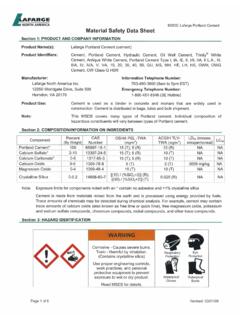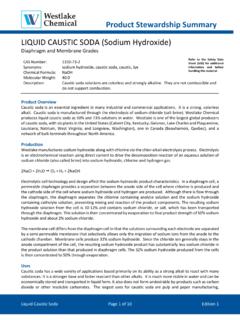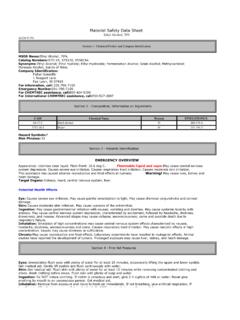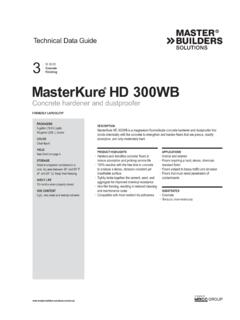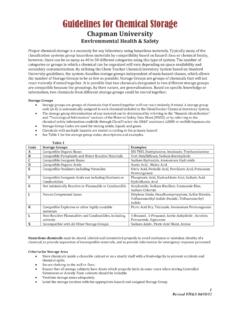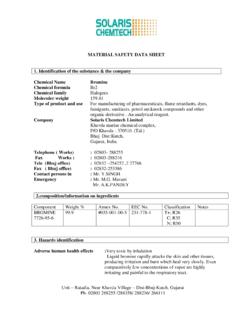Transcription of MATERIAL SAFETY DATA SHEET (MSDS) HYDROCHLORIC …
1 Page 1 of 8 Title: MATERIAL SAFETY data SHEET ( msds ) HYDROCHLORIC ACIDS ection 1: Chemical Product and Company IdentificationProduct Name: HYDROCHLORIC AcidContact Information: ITTEHAD CEHEMICALS LIMITED , KALA SHAH KAKUC hemical Name: Not applicable Web: Name: HYDROCHLORIC acid E-mail: Aqueous Hydrogen Chloride; Muriatic acid PHONE No. 0423-7950222-25 Chemical formula: Not applicableRecommended Use: It is used in textiles, steel and galvanizing industry, metal pickling, gelatin, dyestuffs, pharmaceuticals, synthetic rubber, metal chlorides manufacturing, PVC and sugar industry. Section 2 : Composition and Information on IngredientsComposition:NameCAS #ContentHydrogen Chloride WaterNot ApplicableSection 3: Hazards IdentificationPotential Acute Health Effects:Very hazardous in case of skin contact (corrosive, irritant, permeator), eye contact (irritant, corrosive), of ingestion.
2 Slightly hazardous in case of inhalation (lung sensitizer). Non-corrosive for lungs. Liquid or spray mist may produce tissue damage particularly on mucous membranes of eyes, mouth and respiratory tract. Skin contact may produce burns. Inhalation of the spray mist may produce severe irritation of respiratory tract, characterized by coughing, choking, or shortness of breath. Severe overexposure can result in death. Inflammation of the eye is characterized by redness, watering, and itching. Skin inflammation is characterized by itching, scaling, reddening or occasionally, # HCl- msds -02 Effective Date # 00 Page 2 of 8 Potential Chronic Health Effects:Slightly hazardous in case of skin contact (sensitizer). CARCINOGENIC EFFECTS: Classified 3 (Not classifiable for human.)
3 By IARC [ HYDROCHLORIC acid ]. MUTAGENIC EFFECTS: Not available. TERATOGENIC EFFECTS: Not available. DEVELOPMENTAL TOXICITY: Not available. The substance may be toxic to kidneys, liver, mucous membranes, upper respiratory tract, skin, eyes, Circulatory System, teeth. Repeated or prolonged exposure to the substance can produce target organs damage. Repeated or prolonged contact with spray mist may produce chronic eye irritation and severe skin irritation. Repeated or prolonged exposure to spray mist may produce respiratory tract irritation leading to frequent attacks of bronchial infection. Section 4 : First Aid MeasuresEye Contact: Check for and remove any contact lenses. In case of contact, immediately flush eyes with plenty of water for at least 15 minutes.
4 Cold water may be used. Get medical attention Contact:In case of contact, immediately flush skin with plenty of water for at least 15 minutes while remove contaminated clothing and shoes. Cover the irritated skin with an emollient. Cold water may be used wash clothing before reuse. Thoroughly clean shoes before reuse. Get medical attention immediatelySerious Skin Contact: Wash with a disinfectant soap and cover the contaminated skin with an anti-bacterial cream. Seek immediate medical :If inhaled, remove to fresh air. If not breathing, give artificial respiration. If breathing is difficult, give oxygen. Get medical attention Inhalation:Evacuate the victim to a safe area as soon as possible. Loosen tight clothing such as a collar, tie, belt or waistband. If breathing is difficult, administer oxygen.
5 If the victim is not breathing, perform mouth-to-mouth resuscitation. WARNING: It may be hazardous to the person providing aid to give mouth-to-mouth resuscitation when the inhaled MATERIAL is toxic, infectious or corrosive. Seek immediate medical :If swallowed, do not induce vomiting unless directed to do so by medical personnel. Never give anything by mouth to an unconscious person. Loosen tight clothing such as a collar, tie, belt or waistband. Get medical attention Ingestion: Not availablePage 3 of 8 Section 5: Fire and Explosion DataFlammability of the Product: Non-flammable Auto-Ignition Temperature: Not applicable Flash Points: Not applicableProducts of Combustion: Not availableFire Hazards in Presence of Various Substances: of metalsExplosion Hazards in Presence of Various Substances: Non-explosive in presence of open flames and sparks of Fighting Media and Instructions: Not Remarks on Fire Hazards:Noncombustible.
6 Calcium carbide reacts with hydrogen chloride gas with incandescence. Uranium phosphide reacts with HYDROCHLORIC acid to release spontaneously flammable phosphines. Rubidium acetylene carbides burns with slightly warm HYDROCHLORIC acid . Lithium silicide in contact with hydrogen chloride becomes incandescent. When dilute HYDROCHLORIC acid is used, gas spontaneously flammable in air is evolved. Magnesium boride treated with concentrated HYDROCHLORIC acid produces spontaneously flammable gas. Cesium acetylene carbide burns in hydrogen chloride gas. Cesium carbide ignites in contact with HYDROCHLORIC acid unless acid is dilute. Reacts with most metals to produce flammable Hydrogen gas. Special Remarks on Explosion Hazards:Hydrogen chloride in contact with the following can cause an explosion, ignition on contact, or other violent/vigorous reaction.
7 Acetic anhydride, AgClO + CCl4, Alcohols + hydrogen cyanide, Aluminum- titanium alloys (with HCl vapor), 2-Amino ethanol, Ammonium hydroxide, Calcium carbide, Ca3P2 Chlorine + dinitroanilines (evolves gas), Chlorosulfonic acid , Cesium carbide, Cesium acetylene carbide, 1,1-Difluoroethylene Ethylene diamine, Ethylene imine, Fluorine, HClO4, Hexalithium disilicide, H2SO4, Metal acetylides or carbides, Magnesium boride, Mercuric sulfate, Oleum, Potassium permanganate, beta-Propiolactone, Propylene oxide, Rubidium carbide, Rubidium, acetylene carbide, Sodium (with aqueous HCl), Sodium hydroxide, Sodium tetra selenium, Sulfonic acid , Tetra selenium tetra nitride, U3P4 , Vinyl acetate. Silver per chlorate with carbon tetrachloride in the presence of HYDROCHLORIC acid produces trichloromethyl perchlorate which detonates at 40 6: Accidental Release MeasuresSmall Spill:Dilute with water and mop up, or absorb with an inert dry MATERIAL and place in an appropriate waste disposal container.
8 If necessary: Neutralize the residue with a dilute solution of sodium Spill:Corrosive liquid. Poisonous liquid. Stop leak if without risk. Absorb with DRY earth, sand or other non-combustible MATERIAL . Do not get water inside container. Do not touch spilled MATERIAL . Use water spray curtain to divert vapor drift. Use water spray to reduce vapors. Prevent entry into sewers, basements or confined areas; dike if needed. Call for assistance on disposal. Neutralize the residue with a dilute solution of sodium carbonate. Be careful that the product is not present at a concentration level above TLV. Check TLV on the msds and with local 4 of 8 Section 7: Handling and StoragePrecautions:Keep locked up. Keep container dry. Do not ingest. Do not breathe gas/fumes/ vapor/spray.
9 Never add water to this product. In case of insufficient ventilation, wear suitable respiratory equipment. If ingested, seek medical advice immediately and show the container or the label. Avoid contact with skin and eyes. Keep away from incompatibles such as oxidizing agents, organic materials, metals, alkalis, moisture. May corrode metallic surfaces. Store in a metallic or coated fiberboard drum using a strong polyethylene inner packageStorage:Keep container tightly closed. Keep container in a cool, well-ventilated 8: Exposure Controls/Personal ProtectionEngineering Controls: Provide exhaust, ventilation or other engineering controls to keep the airborne concentrations of vapors below their respective threshold limit value. Ensure that eyewash stations and SAFETY showers are proximal to the work-station Protection: Face shield.
10 Full suit. Vapor respirator. Be sure to use an approved/certified respirator or equivalent. Gloves. Protection in Case of a Large Spill:Splash goggles. Full suit. Vapor respirator. Boots. Gloves. A self-contained breathing apparatus should be used to avoid inhalation of the product. Suggested protective clothing might not be sufficient; consult a specialist before handling this productExposure Limits: CEIL: 5 (ppm) from OSHA (PEL) [United States] CEIL: 7 (mg/m3) from OSHA (PEL) [United States] CEIL: 5 from NIOSH CEIL: 7 (mg/m3) from NIOSH TWA: 1 STEL: 5 (ppm) [United Kingdom (UK)] TWA: 2 STEL: 8 (mg/m3) [United Kingdom (UK)] Consult local authorities for acceptable exposure 9: Physical and Chemical PropertiesAppearance: : Colorless to light : Pungent. Irritating (Strong.)Taste: Not availableMolecular Weight: Not applicablepH (1% soln/water): AcidicPage 5 of 8 Boiling @ 760 mm Hg (for HCl in water) 83 C @ 760 mm Hg (for 31% HCl in water), (for 37% HCl in water)Melting Point: (-80 F) ( HCl in water) ( HCl in water), ( HCl in water) Critical Temperature: Not availableSpecific Gravity: (Water = 1) (20% and 22% HCl solutions) (24% HCl solution) ( HCl solution) (32% HCl solution) (37% and 38%HCl solutions)Vapor Pressure: 16 kPa (@ 20 C) averageVapor Density: (Air = 1)Volatility: Not availableOdor to 10 ppmWater/Oil Dist.

